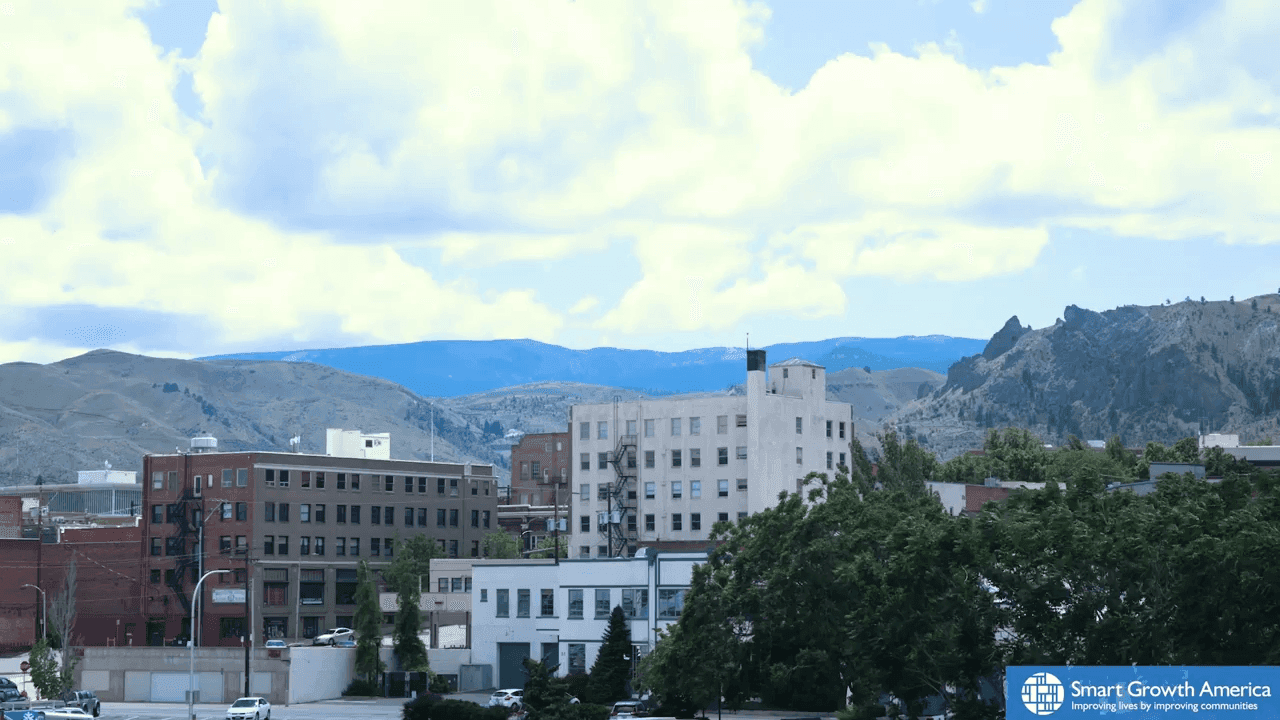
News
By Courtney Cole, October 4, 2023
Made in collaboration with the Washington State Department of Health, our new video tells the story of Wenatchee, Washington—a community that came together to make their streets safer. Watch to hear from community members about how a temporary installation has made a permanent change to their approach to safety and accessibility.
Wenatchee’s story
Wenatchee is a small city of about 35,000 people found in the northern central part of Washington State. The city adopted a Complete Streets policy in 2016 and has done several Complete Streets demonstration, or “quick build,” projects since then to create a safer, more equitable Wenatchee. One of those projects, completed as part of the 2021 Complete Streets Leadership Academy, led to permanent change to an intersection that was not providing safe connectivity for community members.
Click here to watch an audio-described version of this video.
The 2021 Washington Complete Streets Leadership Academy was conducted by the National Complete Streets Coalition in partnership with the Washington Department of Transportation (WSDOT), Washington Department of Health, and Washington Transportation Improvement Board with support from the Centers for Disease Control.
The Academy allowed Wenatchee to collaborate with other small cities and WSDOT through virtual sessions and an in-person workshop. During the program, the Wenatchee team planned and executed a quick-build project, which eventually led to a permanent installation that made Wenatchee safer for people walking, biking, and driving. “Since the improvements went in last summer, there haven’t been any collisions here at the intersection between vehicles, pedestrians, or bikes,” said Jake Lewing, an Engineer for the City of Wenatchee.
The Wenatchee team chose the complex and often dangerous intersection of Okanogan Avenue, Orondo Avenue, and Methow Street where they made temporary changes to create a safer environment for both drivers and pedestrians. They temporarily merged the two lanes on Okanagan approaching Orondo to encourage drivers to slow down before reaching the intersection where pedestrians cross.
Where there was once a single long crosswalk, they used paint to create two shorter crosswalks with a refuge in the middle and an extended curb to decrease the amount of time pedestrians had to spend in front of cars. They also used paint to create a protected bike lane. These actions combined resulted in a slimmer lane where drivers are more likely to drive with caution.
Finally, they blocked off space at the dead end of Methow Street, creating a community plaza that pedestrians could walk through instead of crossing the street while maintaining driver access by reworking the dead end into a two-way cul-de-sac.
The Wenatchee team ensured that the community was part of their quick-build project through events that included a lively pop-up market event at the intersection and neighboring park. It was critical to get information and feedback from all community members including the Spanish speaking-community so all promotional materials were available in Spanish and bilingual staff were present at the event. The feedback provided, both positive and negative, helped make the project even stronger as they moved towards permanent change. As Holton put it, “Some of the most valuable feedback comes from those who don’t see it working…because they’re usually the most honest and critical, and they make you look at your project really closely.”
During the quick build, the Wenatchee team collected invaluable feedback about the temporary street design. Importantly, they also cultivated a sense of community ownership, which was key to building further support for the project.
Jorge Charón, Co-founder of CAFE (Communities for the Advancement of Family Education) on the positive space created during the event: “It felt like you belonged,” he said. “It was a good feeling.”

From possibility to positive change
After a successful quick-build project, Wenatchee made permanent changes based on the elements of the quick build.
They installed a pedestrian refuge in the middle of the crosswalk on Okanagan to decrease the risk a pedestrian faces by decreasing the amount of time they have to spend in front of cars. They also connected gaps in the existing bike lanes, making cyclists less vulnerable to collisions with cars by keeping them in a protected area.
Finally, they encouraged drivers to slow down by merging the two lanes on Okanagan well before the crosswalk. Between this change and the decrease in lane width with the addition of the connected bike lanes and pedestrian refuge, drivers are encouraged to slow down and drive more carefully, which makes everyone safer.
The impact
Wenatchee gained insights from this project that resulted in permanent change and will be incredibly valuable as they continue their Complete Streets work. Identifying the key issues at the project site that could be addressed with temporary measures and including the community in the process were key to creating a quick build that transformed into a positive permanent change. Their work is an excellent example of how valuable quick builds can be when done with collaboration and creativity.
“I think that the community feels good, and I’ll proudly say ‘We had a part in this! See this beautiful place? We had a part in it!’” —Alma Charón, Co-founder of CAFE (Communities for the Advancement of Family Education).
Related News

© 2025 Smart Growth America. All rights reserved
Site By3Lane Marketing
















